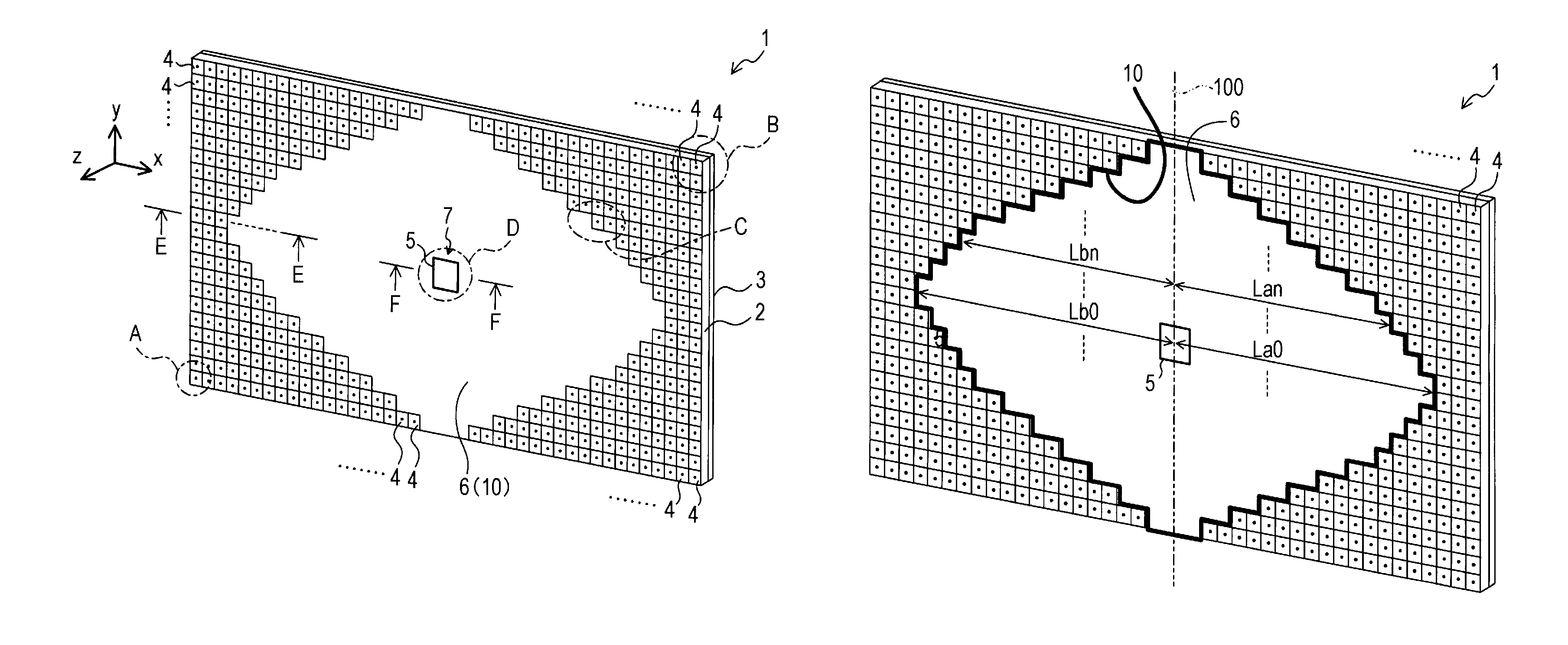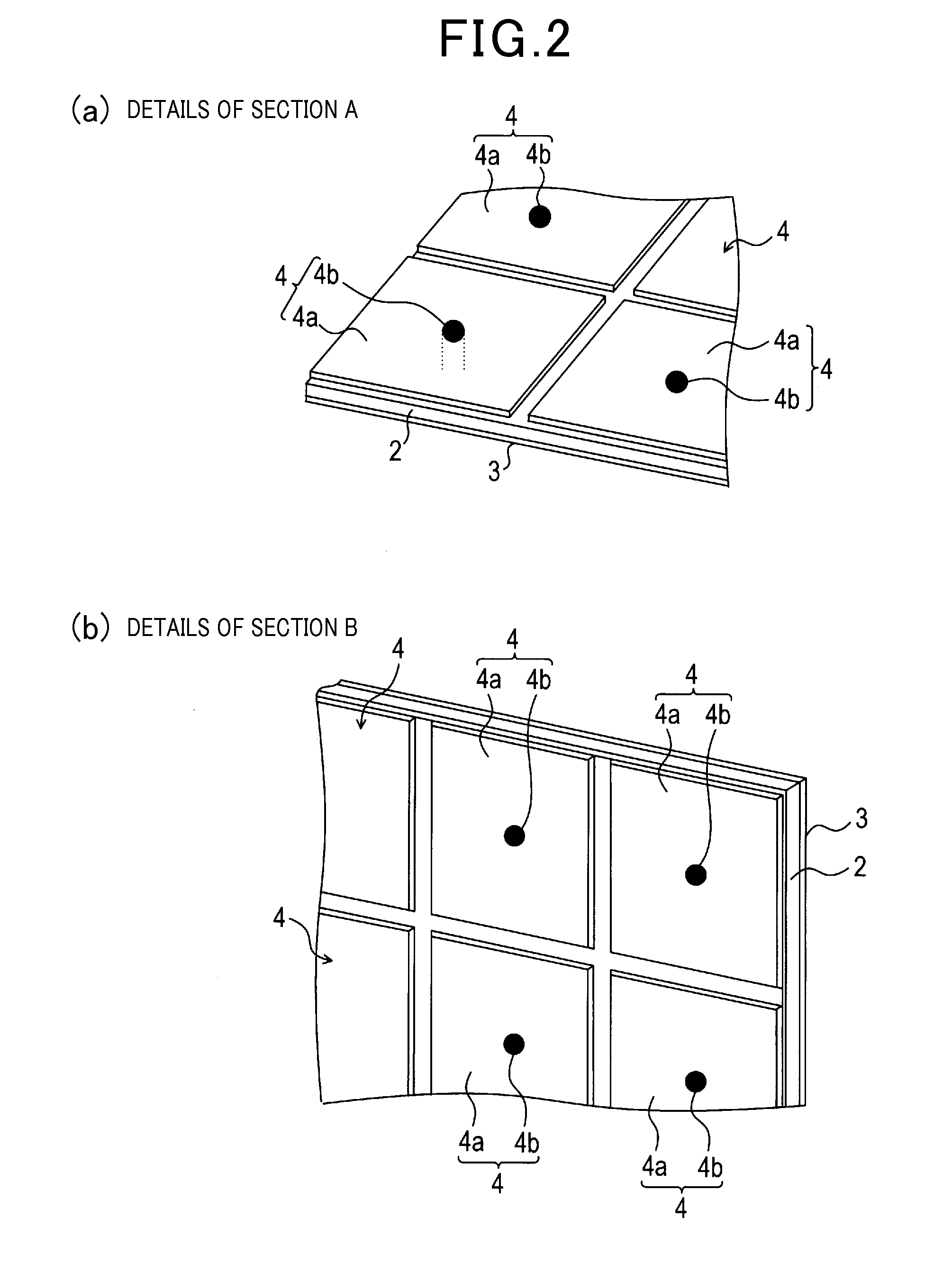Antenna apparatus having patch antenna
a technology of patch antenna and antenna, which is applied in the structure of radiating elements, substantially flat resonant elements, and resonant antennas, etc., can solve the problems of disturbance in the directivity of the patch antenna and affect the performance of the patch antenna, so as to achieve the effect of suppressing disturbance in directivity and retaining desired beam width
- Summary
- Abstract
- Description
- Claims
- Application Information
AI Technical Summary
Benefits of technology
Problems solved by technology
Method used
Image
Examples
first embodiment
[0039]As shown in FIG. 1(a), an antenna apparatus 1 according to the present embodiment is configured such that a patch antenna 7, a conductor plate 6, and a plurality of electromagnetic band gaps (EBGs) 4 are formed on one surface (substrate front surface) of a rectangular dielectric substrate 2. A ground plate (ground plane) 3 composed of a conductor is formed on the other surface (substrate back surface) of the dielectric substrate 2. In the description hereafter, the long-side direction (lateral direction in FIG. 1(a)) of the dielectric substrate 2 is referred to as an x-axis direction. The short-side direction (vertical direction in FIG. 1(a)) of the dielectric substrate 2 is referred to as a y-axis direction. The direction perpendicular to the substrate face of the dielectric substrate 2 is referred to as a z-axis direction.
[0040]FIG. 2(a) and FIG. 2(b) show detailed (enlarged) views of section A and section B, which are indicated by broken-line circles, in the antenna apparat...
second embodiment
[0060]An antenna apparatus 20 according to a second embodiment shown in FIG. 5 differs from the antenna apparatus 1 according to the first embodiment shown in FIG. 1 in terms of the configuration of a patch antenna 25. That is, whereas the patch antenna 7 according to the first embodiment is provided with a single patch radiating element 5, the patch antenna 25 according to the present embodiment is configured such that a plurality (four, in the present embodiment) of patch radiating elements 21, 22, 23, and 24 are arrayed at a predetermined interval in the vertical direction (y-axis direction) in the center portion of the dielectric substrate 2.
[0061]The shape and size of each patch radiating element 21 to 24 are the same as those of the patch radiating element 5 according to the first embodiment. According to the present embodiment, power supply to the patch radiating elements 21 to 24 is configured such that a microstrip line for power supply is branched and the patch radiating e...
third embodiment
[0069]An antenna apparatus 30 according to a third embodiment shown in FIG. 7 differs from the antenna apparatus 20 according to the second embodiment shown in FIG. 5 in terms of the patch radiating elements being formed on both the left and right sides of the patch antenna 25. The antenna apparatus 30 according to the third embodiment is the same as the antenna apparatus 20 according to the second embodiment in terms of other aspects.
[0070]That is, whereas the patch antenna 25 according to the second embodiment is provided with the four patch radiating elements 21 to 24 that are arrayed at a predetermined interval in the vertical direction, the antenna apparatus 30 according to the present embodiment is configured such that a plurality (five, according to the present embodiment) of radiating element groups are arrayed at a predetermined interval in the dominant polarized wave direction. Here, the patch radiating elements 21 to 24 of the patch antenna 25 according to the second embo...
PUM
 Login to View More
Login to View More Abstract
Description
Claims
Application Information
 Login to View More
Login to View More - R&D
- Intellectual Property
- Life Sciences
- Materials
- Tech Scout
- Unparalleled Data Quality
- Higher Quality Content
- 60% Fewer Hallucinations
Browse by: Latest US Patents, China's latest patents, Technical Efficacy Thesaurus, Application Domain, Technology Topic, Popular Technical Reports.
© 2025 PatSnap. All rights reserved.Legal|Privacy policy|Modern Slavery Act Transparency Statement|Sitemap|About US| Contact US: help@patsnap.com



